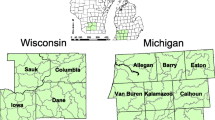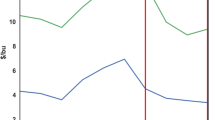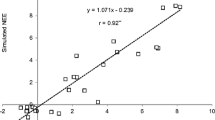Abstract
Bioenergy crop production has the potential to protect marginal crop lands that generate high surface runoff and produce poor crop yields. Long-term evaluation of the impacts of such land use change on hydrologic fluxes and biofuel production potential is necessary before adopting such strategies on a large scale. In this study, the hydrologic impacts of replacing cotton (Gossypium hirsutum L.) on marginal lands in an intensive agricultural watershed in the Texas High Plains with Alamo switchgrass (Panicum virgatum L.) as a bioenergy crop were evaluated using the Agricultural Policy/Environmental eXtender (APEX) model. The surface runoff to cotton yield ratio was used as a criterion to identify marginal cotton subareas (homogenous spatial units delineated by APEX) in the study watershed, and three replacement scenarios (low (9 %), medium (33 %), and high (57 %) extents of cotton acreage replaced by switchgrass) were implemented in the scenario analysis. The average (1994–2009) annual surface runoff decreased by about 84 and 66 %, and the percolation increased by 106 and 57 % in the irrigated and dryland subareas, respectively, when cotton was replaced by switchgrass under the high replacement scenario. Spatial analysis showed that switchgrass was a feasible bioenergy crop for replacing cotton, especially in the western part of the study watershed, due to its higher water use efficiency and better water conservation effects compared to cotton. It is estimated that 193 and 381 million liters of ethanol could be produced from the dryland and irrigated subareas of the study watershed, respectively, under the high replacement scenario.








Similar content being viewed by others
References
EISA (Energy Independence and Security Act) of 2007 Public Law 110–140, (2007) http://www.gpo.gov/fdsys/pkg/PLAW-110publ140/pdf/PLAW-110publ140.pdf (Accessed 3 Sep 2015)
Ayre M (2007) “Will biofuel leave the poor hungry?”. BBC News. Available online at http://news.bbc.co.uk/2/hi/business/7026105.stm (Accessed 4 Aug 2015)
Tenenbaum DJ (2008) Food vs. fuel: diversion of crops could cause more hunger. Environ Health Perspect 116:254–257
Hill J, Nelson E, Tilman D, Polasky S, Tiffany D (2006) Environmental, economic, and energetic costs and benefits of biodiesel and ethanol biofuels. PNAS 103:11206–11210
Campbell JE, Lobell DB, Genova RC, Field CB (2008) The global potential of bioenergy on abandoned agriculture lands. Environ Sci Technol 42:5791–5794
Searchinger T, Heimlich R, Houghton RA et al (2008) Use of US croplands for biofuels increases greenhouse gases through emissions from land-use change. Science 319:1238–1240
Qin ZC, Zhuang QL, Zhu XD, Cai XM, Zhang X (2011) Carbon consequences and agricultural implications of growing biofuel crops on marginal agricultural lands in China. Environ Sci Technol 45:10765–10772
Qin ZC, Zhuang QL, Cai XM (2014) Bioenergy crop productivity and potential climate change mitigation from marginal lands in the United States: an ecosystem modeling perspective. Glob Chang Biol Bioenergy. doi:10.1111/gcbb.12212
Cai XM, Zhang X, Wang DB (2011) Land availability for biofuel production. Environ Sci Technol 45:334–339
Graham RL (1994) An analysis of the potential land base for energy crops in the conterminous United States. Biomass Bioenergy 6:175–189
Chaudhuri S, Ale S (2014) Long-term (1930–2010) trends in groundwater levels in Texas: influences of soils, landcover and water use. Sci Total Environ 490:379–390
Rajan N, Maas SJ, Kellison R, Dollar M, Cui S, Sharma S, Attia A (2015) Emitter uniformity and application efficiency for center-pivot irrigation systems. Irrig Drain. doi:10.1002/ird.1878
Rosenberg NJ, Epstein DJ, Wang D, Vail L, Srinivasan R, Arnold JG (1999) Possible impacts of global warming on the hydrology of the Ogallala Aquifer region. Clim Chang 42:677–692
Modala NR, Ale S, Goldberg D, Olivares M, Munster C, Rajan N, Feagin R (2016) Climate change projections for the Texas High Plains and Rolling Plains. Theor Appl Climatol. doi:10.1007/s00704-016-1773-2
USDA (2010) A USDA Regional roadmap to meeting the biofuels goals of the Renewable Fuels Standard by 2022. Biofuels strategic production report. USDA, Washington, DC. Available online at http://www.usda.gov/documents/USDA_Biofuels_Report_6232010.pdf (Accessed 3 Sep 2015)
Kiniry JR, Lynd L, Greene N, Johnson MVV, Casler M, Laser MS (2008) Biofuels and water use: comparison of maize and switchgrass and general perspectives. New Research on Biofuels. Nova Science Publ, New York
Kiniry JR, Anderson LC, Johnson MVV et al (2013) Perennial biomass grasses and the Mason-Dixon line: comparative productivity across latitudes in the Southern Great Plains. BioEnergy Res 6:276–291
Chen Y, Ale S, Rajan N, Morgan CLS, Park JY (2015) Hydrological responses of land use change from cotton (Gossypium hirsutum L.) to cellulosic bioenergy crops in the Southern High Plains of Texas, USA. Glob Chang Biol Bioenergy. doi:10.1111/gcbb.12304
Behrman KD, Keitt TH, Kiniry JR (2014) Modeling differential growth in switchgrass cultivars across the central and Southern Great Plains. BioEnergy Res 7:1165–1173
Kiniry JR, Johnson MVV, Bruckerhoff SB, Kaiser JU, Cordsiemon RS, Harmel RD (2012) Clash of the Titans: comparing productivity via radiation use efficiency for two grass giants of the biofuel field. BioEnergy Res 5(1):41–48
Wang T, Park S, Ansley RJ, Amosson SH (2014) Economic and greenhouse gas efficiency of honey mesquite relative to other energy feedstocks for bioenergy uses in the Southern Great Plains. BioEnergy Res 7:1493–1505
Sarkar S, Miller SA (2014) Water quality impacts of converting intensively-managed agricultural lands to switchgrass. Biomass Bioenergy 68:32–43
Schilling KE, Jha MK, Zhang YK, Gassman PW, Wolter CF (2008) Impact of land use and land cover change on the water balance of a large agricultural watershed: historical effects and future directions. Water Resour Res 44:W00A09
Feng QY, Chaubey I, Gu Her Y, Cibin R, Engel B, Volenec J, Wang XY (2015) Hydrologic and water quality impacts and biomass production potential on marginal land. Environ Model Softw 72:230–238
Powers SE, Ascough JC II, Nelson RG, Larocque GR (2011) Modeling water and soil quality environmental impacts associated with bioenergy crop production and biomass removal in the Midwest USA. Ecol Model 222:2430–2447
Wu YP, Liu SG (2012) Impacts of biofuels production alternatives on water quantity and quality in the Iowa River Basin. Biomass Bioenergy 36:182–191
Ko JH, Piccinni G, Steglich E (2009) Using EPIC model to manage irrigated cotton and maize. Agric Water Manag 96:1323–1331
Gassman PW, Williams JR, Wang X, Saleh A, Osei E, Hauck LM, Izaurralde RC, Flowers JD (2010) The agricultural policy/environmental extender (APEX) model: an emerging tool for landscape and watershed environmental analyses. Trans ASABE 53:711–740
Tuppad P, Santhi C, Wang X, Williams JR, Srinivasan R, Gowda PH (2010) Simulation of conservation practices using the APEX model. Trans ASABE 26:779–794
Wang X, Kannan N, Santhi C, Potter SR, Williams JR, Arnold JG (2011) Integrating APEX output for cultivated cropland with SWAT simulation for regional modeling. Trans ASABE 54:1281–1298
Wang X, Yen H, Liu Q, Liu J (2014) An auto-calibration tool for the agricultural policy environmental extender (APEX) model. Trans ASABE 57:1–12
Saleh A, Gallego O (2007) Application of SWAT and APEX using the SWAPP (SWAT-APEX Program) for the upper North Bosque River watershed in Texas. Trans ASABE 50(4):1177–1187
Jung CG, Park JY, Kim SJ, Park GA (2014) The SRI (system of rice intensification) water management evaluation by SWAPP (SWAT-APEX Program) modeling in an agricultural watershed of South Korea. Paddy Water Environ 12:251–261
Soil Survey Staff (2010) Keys to soil taxonomy, 11th edn. USDA-Natural Resources Conservation Service, Washington, DC
NOAA-NCDC (National Oceanic and Atmospheric Administration-National Climatic Data Center) (2014) Weather Data. Available online: http://gis.ncdc.noaa.gov/map/viewer/#app=cdo&cfg=cdo&theme=daily&layers=111&node=gis (Accessed 2 Sep 2015)
Williams JR (1995) The EPIC model. In: Singh VP (ed) Computer models of watershed hydrology. Water Resources Publications, Highlands Ranch, pp 909–1000
Williams JR, Arnold JG, Kiniry JR, Gassman PW, Green CH (2008) History of model development at Temple, Texas. Hydrol Sci J 53:948–960
Golmohammadi G, Prasher S, Madani A, Rudra R (2014) Evaluating three hydrological distributed watershed models: MIKE-SHE, APEX, SWAT. Hydrology 1:20–39
Tuppad P, Winchell MF, Wang X, Srinivasan R, Williams JR (2009) ArcAPEX: ArcGIS interface for agricultural policy environmental extender (APEX) hydrology/water quality model. Int Agric Eng J 18:59–71
Wang X, Williams JR, Gassman PW, Baffaut C, Izaurralde RC, Jeong J, Kiniry JR (2012) EPIC and APEX: model use, calibration, and validation. Trans ASABE 55:1447–1462
USDA-NRCS (2004) Chapter 10: estimation of direct runoff from storm rainfall. In NRCS National Engineering Handbook, Part 630: Hydrology, 10.1-10.22. Washington, D.C.: USDA National Resource Conservation Service. Available online at: http://directives.sc.egov.usda.gov/viewerFS.aspx?hid=21422 (Accessed 4 Sep 2015)
Green WH, Ampt GA (1911) Studies on soil physics: 1. Flow of air and water through soils. J Agric Sci 4:1–24
USDA-NRCS (1986) Urban hydrology for small watersheds. Technical release 55. Washington, D.C.: USDA National Resource Conservation Service. Available online at: www.hydrocad.net/pdf/TR‐55%20Manual.pdf (Accessed 3 Sep 2015)
Hargreaves GH, Samani ZA (1985) Reference crop evapotranspiration from temperature. Appl Eng Agric 1(2):96–99
Penman HL (1948) Natural evaporation from open water, bare soil, and grass. Proc R Soc Lond A 193(1032):120–145
Priestley CHB, Taylor RJ (1972) On the assessment of surface heat flux and evaporation using large-scale parameters. Mon Weather Rev 100(2):81–92
Monteith JL (1965) Evaporation and environment. Symp Soc Exp Biol 19:205–234
Baier W, Robertson GW (1965) Estimation of latent evaporation from simple weather observations. Can J Plant Sci 45:276–284
Williams JR, Jones CA, Kiniry JR, Spanel DA (1989) The EPIC crop growth model. Trans ASABE 32(2):497–511
Williams JR, Izaurralde RC (2006) The APEX model. In: Singh VP, Frevert DK (eds) Watershed models. CRC Press, Boca Raton, pp 437–482
Soil Survey Staff (2015) Natural Resources Conservation Service, United States Department of Agriculture. Soil Survey Geographic (SSURGO) Database for [Survey Area, State]. Available online at http://www.arcgis.com/apps/OnePane/basicviewer/index.html?appid=a23eb436f6ec4ad6982000dbaddea5ea (Accessed 6 Sep 2015)
Mednick AC (2010) Does soil data resolution matter? State soil geographic database versus soil survey geographic database in rainfall-runoff modeling across Wisconsin. J Soil Water Conserv 65:190–199
Zhang X, Sahajpal R, Manowitz DH, Zhao K, LeDuc SD, Xu M, Xiong W, Zhang A, Izaurralde RC, Thomson AM (2014) Multi-scale geospatial agroecosystem modeling: a case study on the influence of soil data resolution on carbon budget estimates. Sci Total Environ 479:138–150
Ale S, Bowling LC, Brouder SM, Frankenberger JR, Youssef MA (2009) Simulated effect of drainage water management operational strategy on hydrology and crop yield for drummer soil in the Midwestern United States. Agric Water Manag 96:653–665
Daggupati P, Pai N, Ale S, Douglas-Mankin KR, Zeckoski RW, Jeong J, Parajuli PB, Saraswat D, Youssef MA (2015) A recommended calibration and validation strategy for hydrologic and water quality models. Trans ASABE 58:1705–1719
Sarkar S, Miller SA, Frederick JR, Chamberlain JF (2011) Modeling nitrogen loss from switchgrass agricultural systems. Biomass Bioenergy 35:4381–4389
Wanjura JD, Barnes EM, Kelley MS, Holt GA, Pelletier MG (2014) Quantification and characterization of cotton crop biomass residue. Ind Crop Prod 56:94–104
Zhang XS, Izaurralde RC, Arnold JG, Williams JR, Srinivasan R (2013) Modifying the soil and water assessment tool to simulate cropland carbon flux: model development and initial evaluation. Sci Total Environ 463:810–822
Mittelstet AR, Storm DE, Stoecker AL (2015) Using SWAT and an empirical relationship to simulate crop yields and salinity levels in the North Fork River Basin. Int J Agric Biol Eng. doi:10.3965/j.ijabe.20150801.008
Zhang XS, Izaurralde RC, Manowitz DH, Sahajpal R, West TO, Thomson AM, Xu M, Zhao KG, LeDuc SD, Williams JR (2015) Regional scale cropland carbon budgets: evaluating a geospatial agricultural modeling system using inventory data. Environ Model Softw 63:199–216
Faramarzi M, Abbaspour KC, Schulin R, Yang H (2009) Modeling blue and green water resources availability in Iran. Hydrol Process 23:486–501
Faramarzi M, Yang H, Schulin R, Abbaspour KC (2010) Modeling wheat yield and crop water productivity in Iran: implications of agricultural water management for wheat production. Agric Water Manag 97:1861–1875
Akhavan S, Abedi-Koupai J, Mousavi SF, Afyuni M, Eslamian SS, Abbaspour KC (2010) Application of SWAT model to investigate nitrate leaching in Hamadan-Bahar Watershed, Iran. Agric Ecosyst Environ 139:675–688
Legates DR, McCabe GJ Jr (1999) Evaluating the use of “goodness-of-fit” measures in hydrologic and hydroclimatic model validation. Water Resour Res 35:233–241
Nash JE, Sutcliffe JV (1970) River flow forecasting through conceptual models, Part I-a discussion of principles. J Hydrol 10:282–290
Musick JT, Jones OR, Stewart BA, Dusek DA (1994) Water-yield relationships for irrigated and dryland wheat in the U.S. Southern Plains. Agron J 86:980–986
Howell TA (2001) Enhancing water use efficiency in irrigated agriculture. Agron J 93:281–289
Bos MG (1980) Irrigation efficiencies at crop production level. ICID Bull 29(18–25):60
Kiniry JR, Sanderson MA, Williams JR, Tischler CR, Hussey MA, Ocumpaugh WR, Read JC, Van Esbroeck G, Reed RL (1996) Simulating Alamo switchgrass with the ALMANAC model. Agron J 88:602–606
Yimam YT, Ochsner TE, Kakani VG, Warren JG (2014) Soil moisture dynamics and evapotranspiration under annual and perennial bioenergy crops. Soil Sci Soc Am J 78:1584–1592
Moriasi DN, Arnold JG, Van Liew MW, Binger RL, Harmel RD, Veith T (2007) Model evaluation guidelines for systematic quantification of accuracy in watershed simulations. Trans ASABE 50:885–900
Harmel RD, Smith PK, Migliaccio KW, Chaubey I, Douglas-Mankin KR, Benham B, Shukla S, Muñoz-Carpena R, Robson BJ (2014) Evaluating, interpreting, and communicating performance of hydrologic/water quality models considering intended use: a review and recommendations. Environ Model Softw 57:40–51
McLaughlin SB, Adams KL (2005) Development of switchgrass (Panicum virgatum) as a bioenergy feedstock in the United States. Biomass Bioenergy 28:515–535
Chaudhuri S, Ale S (2014) Long-term (1960–2010) trends in groundwater contamination and salinization in the Ogallala Aquifer in Texas, USA. J Hydrol 513:376–390
Le PVV, Kumar P, Drewry DT (2011) Implications for the hydrologic cycle under climate change due to the expansion of bioenergy crops in the Midwestern United States. PNAS 108:15085–15090
VanLoocke A, Bernacchi CJ, Twine TE (2010) The impacts of Miscanthus × giganteus production on the Midwest US hydrologic cycle. Glob Chang Biol Bioenergy 2:180–191
Agricultural Resources and Environmental Indicators (1996–97) U.S. Department of Agriculture, Economic Research Service, Natural Resources and Environment Division. Agricultural Handbook No. 712
Ton P (2004) Cotton and climate change in west Africa. Impact Clim Chang Drylands Environ Policy Vol 39:97–115
Yimam YT, Ochsner TE, Kakani VG (2015) Evapotranspiration partitioning and water use efficiency of switchgrass and biomass sorghum managed for biofuel. Agric Water Manag 155:40–47
HPUWCD (High Plains Underground Water Conservation District) (2015) Rule 5 recording and reporting requirements. Available at: http://static1.squarespace.com/static/53286fe5e4b0bbf6a4535d75/t/54db8326e4b09b0ec42ee61d/1423672102940/%28RuleExplanationRevised.pdf (Accessed 18 July 2015)
Nelson RG, Ascough JC II, Langemeier MR (2006) Environmental and economic analysis of switchgrass production for water quality improvement in northeast Kansas. J Environ Manag 79:336–347
Cibin R, Trybula E, Chaubey I, Brouder S, Volenec JJ (2015) Watershed scale impacts of bioenergy crops on hydrology and water quality using improved SWAT model. Glob Chang Biol Bioenergy. doi:10.1111/gcbb.12307
Acknowledgments
This material is based upon work that is supported by the National Institute of Food and Agriculture, US Department of Agriculture, under award number NIFA-2012-67009-19595. Any opinions, findings, conclusions, or recommendations expressed in this publication are those of the author(s) and do not necessarily reflect the view of the US Department of Agriculture. We gratefully thank the two anonymous reviewers and the Editor for their valuable suggestions and comments for improving this paper.
Author information
Authors and Affiliations
Corresponding author
Electronic Supplementary Material
Below is the link to the electronic supplementary material.
ESM 1
(DOCX 1965 kb)
Rights and permissions
About this article
Cite this article
Chen, Y., Ale, S. & Rajan, N. Spatial Variability of Biofuel Production Potential and Hydrologic Fluxes of Land Use Change from Cotton (Gossypium hirsutum L.) to Alamo Switchgrass (Panicum virgatum L.) in the Texas High Plains. Bioenerg. Res. 9, 1126–1141 (2016). https://doi.org/10.1007/s12155-016-9758-7
Published:
Issue Date:
DOI: https://doi.org/10.1007/s12155-016-9758-7




